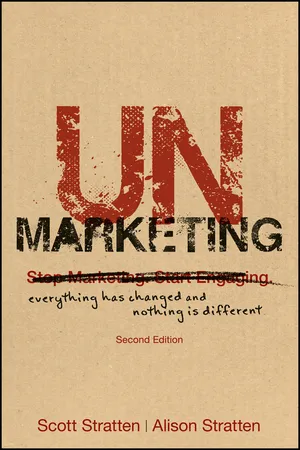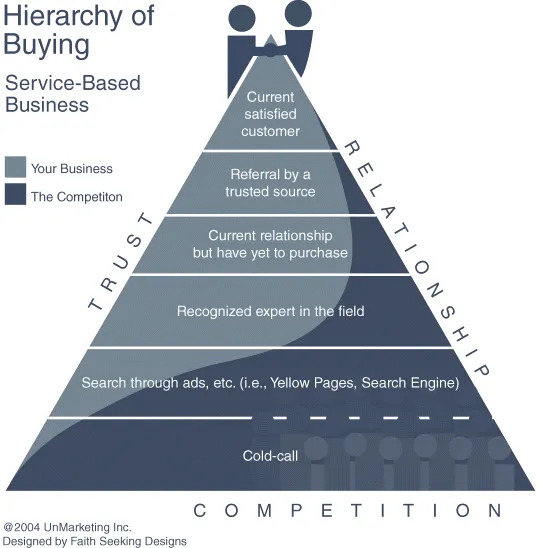
UnMarketing
Everything Has Changed and Nothing is Different
- English
- ePUB (mobile friendly)
- Available on iOS & Android
About this book
UnMarket to build trust and make lifelong customers!
In 2009, Scott Stratten and Alison Stratten wrote the bestselling UnMarketing: Stop
Marketing, Start Engaging
and began a journey that would take them around the world sharing their message of engagement with corporations, entrepreneurs, and students.They are now back with this second edition, because Everything has Changed and Nothing is Different, with all the brilliance of the first edition, plus new content and commentary to reflect the rapidly changing landscape we all live, buy, and work in today.
For generations, marketing has been hypocritical. We've been taught to market to others in ways we hate being marketed to (cold-calling, flyers, ads, etc.). So why do we still keep trying the same stale marketing moves?
UnMarketing shows you how to unlearn the old ways and consistently attract and engage the right customers. You'll stop just pushing out your message and praying that it sticks somewhere. Potential and current customers want to be listened to, validated, and have a platform to be heard-especially online. With UnMarketing, you'll create a relationship with your customers, and make yourself the logical choice for their needs. We know you've been told to act like other people, talk like other people, and market like all the people, but it is time for you to unlearn everything and start to UnMarket yourself.
UnMarketing includes the latest information on:
Idea Creation, Viral Marketing and Video, Marketing to Millennials, Authenticity, Transparency and Immediacy, Ethics and Affiliates, Social Media Platforming, UnPodcasting, Word of Mouth, Customer Service, Consumer Advocacy and Leadership.
With examples of what to do, and what not to do, from small business right up to worldwide corporations in areas such as real estate, travel, service, retail, and B2B.
Frequently asked questions
- Essential is ideal for learners and professionals who enjoy exploring a wide range of subjects. Access the Essential Library with 800,000+ trusted titles and best-sellers across business, personal growth, and the humanities. Includes unlimited reading time and Standard Read Aloud voice.
- Complete: Perfect for advanced learners and researchers needing full, unrestricted access. Unlock 1.4M+ books across hundreds of subjects, including academic and specialized titles. The Complete Plan also includes advanced features like Premium Read Aloud and Research Assistant.
Please note we cannot support devices running on iOS 13 and Android 7 or earlier. Learn more about using the app.
Information
1
Everything Has Changed and Nothing Is Different
Note
2
The Hierarchy of Buying

- Current satisfied customer. Obviously, people are going to buy from you if they already do and are satisfied. The key term here is satisfied. Even though customers are current, this doesn't mean they are happy.
- Referral by a trusted source. The first thing we do when we need something we don't already have is to ask people we know and trust if they know of a provider, which is easy with sites like Facebook and Twitter. We can get a pile of recommendations in minutes. Are you on the tip of the tongue when someone asks for recommendations within your industry?
- Current relationship but have yet to purchase. Potential customers know you, trust you, but have yet to buy from you. And that's okay. The key here is that when they have the need for your product or service, you are in the front of their minds.
- Recognized expert in the field. You've built a platform and are consistently in front of potential customers with helpful advice and tips that relate to your industry. You want your market to say, “This guy/girl knows what he/she is talking about! I need to learn more about this person.” If done right, this leads them into “current relationship” status.
- Search through ads, random searches, and so forth. We get close to the bottom of the barrel here. Potential customers don't know anyone who provides the service, and have never met anyone, so they randomly search for a business that can help. You're not only at the mercy of a search engine here, but price now becomes a huge decider to the point that you almost become a commodity seller. You don't want to be here.
- Cold-call. Most of your market isn't sitting around saying, “You know, I need an accountant to help my growing business, so I'm just going to sit here until someone randomly phones me to offer me that service.” Cold-calling is time-intensive with horrible results. Companies encourage it because it has a “low cost” up front, but what's the cost of annoying 99 people in a row to potentially talk to someone who may hire you based on no trust and price alone? We're starting a movement to change the phrase from “cold-calling” to “telespam.” That will put a stop to the courses; no one is going to sell an e-book about “The Top 10 Ways to Better Telespam!”1
Table of contents
- Cover
- Other Titles from Scott and Alison
- Title Page
- Copyright
- Introduction
- Chapter 1: Everything Has Changed and Nothing Is Different
- Chapter 2: The Hierarchy of Buying
- Chapter 3: A Word on Experts
- Chapter 4: Trust Gap
- Chapter 5: ROD: Return on Donuts
- Chapter 6: Restaurant That Didn't Get It
- Chapter 7: Cold-Calling
- Chapter 8: Aiming Your Company at the Bottom of the Barrel
- Chapter 9: Pull and Stay
- Chapter 10: Reasons Why Companies Don't Use Social Media
- Chapter 11: Social Media (Social Currency as Well)
- Chapter 12: Twitter versus Facebook versus LinkedIn
- Chapter 13: Social Media Platforming
- Chapter 14: UnPodcasting
- Chapter 15: HARO
- Chapter 16: The Game Has Changed: Immediacy and Relevancy
- Chapter 17: Publicized Customer Service
- Chapter 18: Don't Bank on the Bold
- Chapter 19: Seven Deadly Social Media Sins
- Chapter 20: The Millennials Are Coming
- Chapter 21: How Twitter Changed Scott's Business
- Chapter 22: Tassimo
- Chapter 23: Domino's—Word of Mouth: Mouths Are Moving…
- Chapter 24: Naked Pizza
- Chapter 25: Don't Feed the Trolls
- Chapter 26: Social Media for Social Good
- Chapter 27: Your Website—Old School versus New School
- Chapter 28: Your Captcha Is Craptcha
- Chapter 29: Experience Gap
- Chapter 30: Raising and Keeping the Bar High—Cirque
- Chapter 31: Stirring Coffee
- Chapter 32: Using “Stop Start Continue”
- Chapter 33: Zappos
- Chapter 34: Rockport
- Chapter 35: FreshBooks
- Chapter 36: Why You Can't Learn from Millionaires
- Chapter 37: Authenticity and Transparency
- Chapter 38: For Whom the Bell Mobility Tolls
- Chapter 39: Scott's Transparency on Twitter
- Chapter 40: Your Transparency
- Chapter 41: Affiliates
- Chapter 42: Testimonials
- Chapter 43: Best Sellers
- Chapter 44: Why Being a Work-at-Home Mom Is Bad for Business
- Chapter 45: Hello? Walmart?
- Chapter 46: Idea Creation
- Chapter 47: Idea Delivery
- Chapter 48: Doing In-Person Seminars
- Chapter 49: Tele-Seminars (now Webinars)
- Chapter 50: Viral Marketing
- Chapter 51: Video
- Chapter 52: Be Prepared for Success
- Chapter 53: Undercover UnMarketing
- Chapter 54: Putting It Into Practice
- Chapter 55: Lush
- Chapter 56: Trade Shows
- Chapter 57: Social Media at Trade Shows
- Chapter 58: UnNetworking: Why Networking Events Are Evil
- Chapter 59: The Awesomeness of Being a 2.0 Author
- Chapter 60: The UnTour
- Chapter 61: The UnEnd
- Index
- End User License Agreement